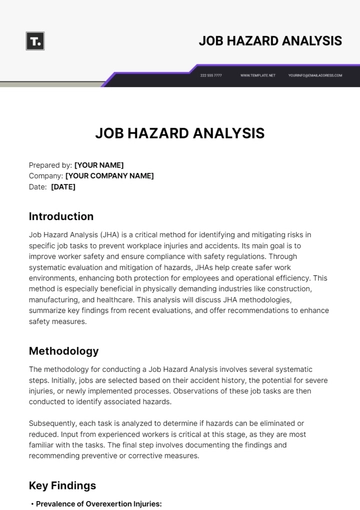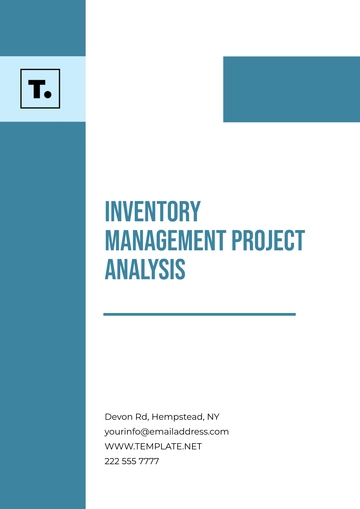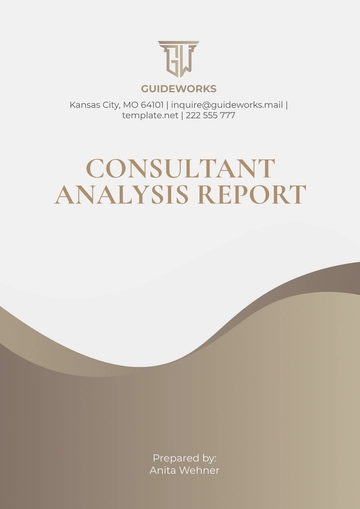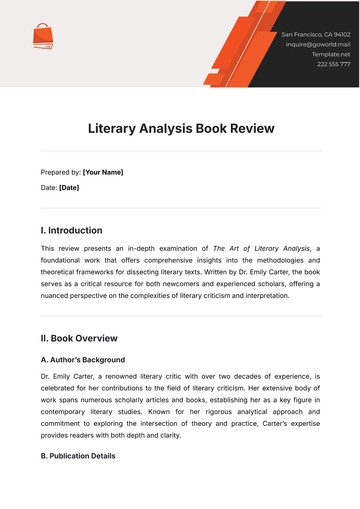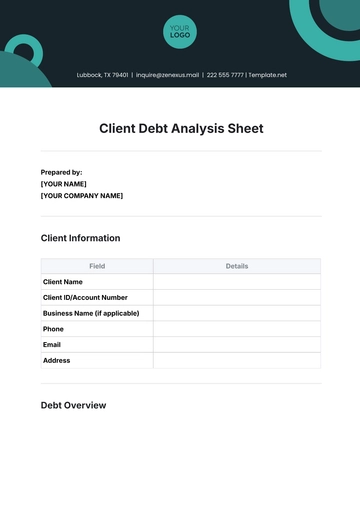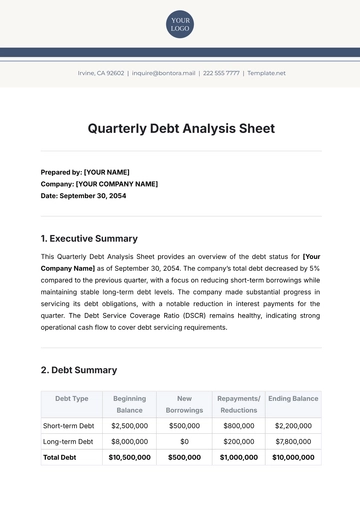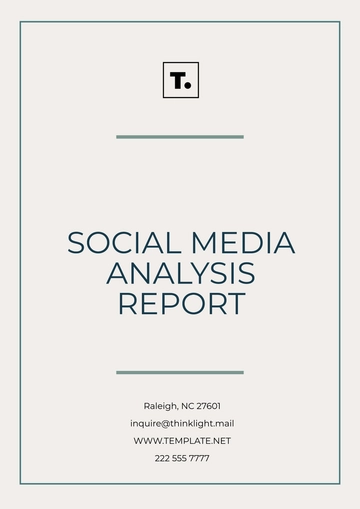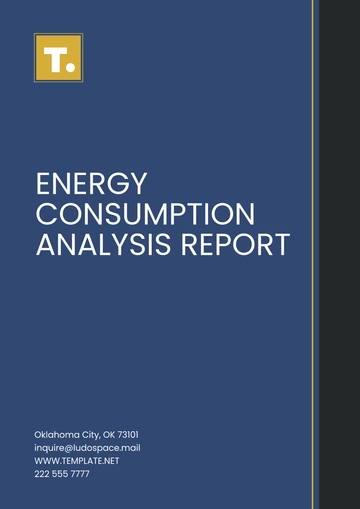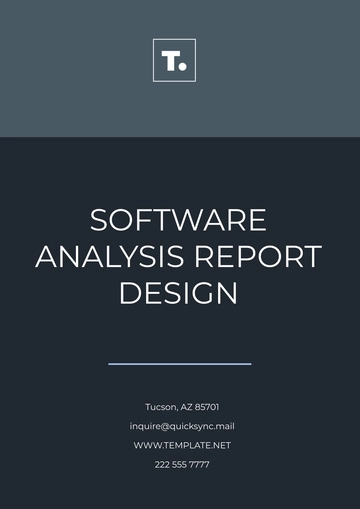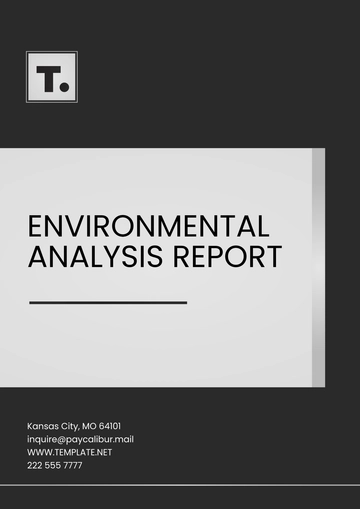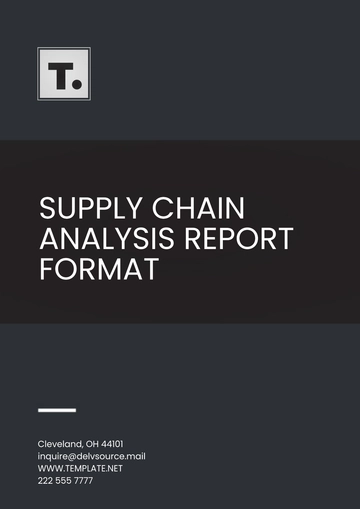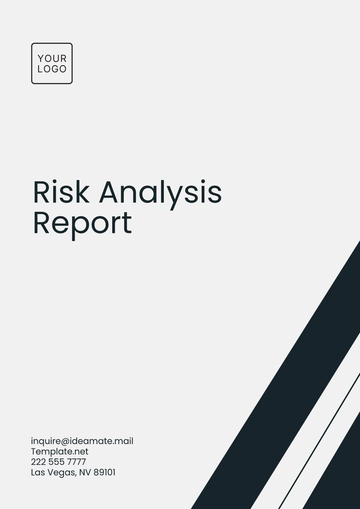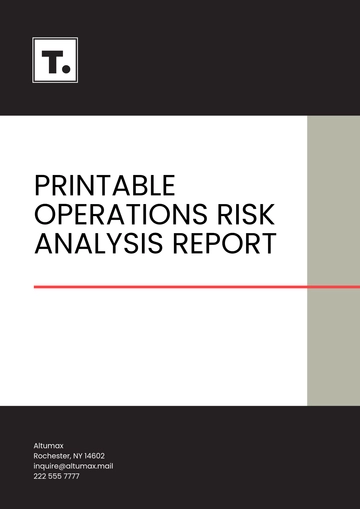Free Finance Credit Analysis Journal

Introduction
Maintaining and managing credit health is crucial for the sustainability and growth of any enterprise. Recognizing this critical need, the Finance Credit Analysis Journal has been meticulously crafted to serve as an indispensable resource for [Your Company Name]. This document is more than just a compilation of financial data; it's a strategic tool designed to navigate the complexities of credit management. Through its detailed structure, this journal will guide you in thoroughly assessing credit risk, a fundamental component in safeguarding your company's financial stability. It delves into the intricate aspects of financial analysis, uncovering the nuances of your company's fiscal health and performance. Moreover, the journal extends its scope to encapsulate prevailing market trends, offering a broader perspective on how external factors influence credit standing. An essential part of this journal is its focus on strategies for credit improvement. These strategies are tailored to empower [Your Company Name] in enhancing its creditworthiness, thus fostering better opportunities for growth and investment. By integrating this comprehensive approach, the Finance Credit Analysis Journal stands as a pivotal instrument in fortifying your business's credit position, ensuring informed decision-making, and driving long-term financial success.
Company and Analyst Information
This section of the Finance Credit Analysis Journal provides essential details about both the company under evaluation and the analyst conducting the assessment. It is a quick reference guide that includes fundamental contact information and relevant identifiers. For [Your Company Name], this encompasses the primary contact details such as the company's official email address, website, physical address, phone number, and social media channels. This information is crucial for establishing the business's identity and facilitating efficient communication. Additionally, the section outlines the details of the analyst responsible for this credit analysis, including their name, personal contact email, and phone number. This personalization ensures accountability and provides a direct line of communication for any queries or discussions regarding the analysis. Lastly, the document creation date, marked as [Month Day Year], is specified to contextualize the analysis within a specific time frame, an important aspect for understanding the temporal relevance of the financial data and insights provided in this journal.
Company Information:
Company Name: [Your Company Name]
Contact Email: [Your Company Email]
Website: [Your Company Website]
Address: [Your Company Address]
Phone Number: [Your Company Phone Number]
Social Media: [Your Social Media]
Analyst Information:
Analyst Name: [Your Name]
Contact Email: [Your Personal Email]
Phone Number: [Your User Phone]
Document Creation Date:
Date: [Month Day Year]
Financial Performance Analysis
This chapter provides a comprehensive view of [Your Company Name]'s financial performance through detailed analyses of income statements and balance sheets. This examination is critical for understanding the company's profitability, asset management, and financial stability over time.
Balance Sheet Analysis
The Balance Sheet Analysis reflects the financial position of [Your Company Name] at the end of each fiscal year. It provides data on total assets, total liabilities, and equity, crucial for understanding the company's financial health and ability to meet its obligations.
Year | Total Assets | Total Liabilities | Equity | Net Income |
|---|---|---|---|---|
2050 | $800,000 | $400,000 | $400,000 | $75,000 |
2051 | $850,000 | $410,000 | $440,000 | $80,000 |
2052 | $900,000 | $420,000 | $480,000 | $90,000 |
2053 | $950,000 | $430,000 | $520,000 | $105,000 |
2054 | $1,000,000 | $450,000 | $550,000 | $110,000 |
The table, complete with financial figures, present a clear and concise picture of the financial trajectory and stability of [Your Company Name]. They are instrumental in making informed decisions for future growth and financial planning.
Key Financial Ratios Analysis
This table with specific data provides a comprehensive view of the credit status and financial responsibilities of [Your Company Name], aiding in effective credit risk management and strategic financial planning.
Year | Debt Ratio | Current Ratio | Return on Equity |
|---|---|---|---|
2050 | 50% | 2.00 | 18.75% |
2051 | 48.24% | 2.07 | 18.18% |
2052 | 46.67% | 2.14 | 18.75% |
2053 | 45.26% | 2.21 | 20.19% |
2054 | 45.00% | 2.22 | 20.00% |
Market Trends and Credit Environment
This section is dedicated to analyzing the external factors that influence [Your Company Name]'s credit environment. It focuses on understanding industry-specific credit trends and the broader regulatory and economic factors that can impact credit conditions.
Industry Credit Trends
Current Industry Conditions:
Current Industry Conditions examines the current state of the industry in which [Your Company Name] operates. It includes an analysis of market stability, industry growth rates, and prevailing business cycles. For instance, in a booming industry, companies might experience more lenient credit terms due to heightened market confidence. Conversely, in a contracting industry, credit terms might become stricter.
Market Credit Trends:
Market Credit Trends delves into the general credit trends within the market, such as prevailing interest rates, lending practices, and credit availability. It is essential to understand how these trends affect the company's ability to obtain and manage credit. For example, in a low-interest-rate environment, businesses might find it easier to service debt, whereas high interest rates could lead to increased borrowing costs.
Comparative Analysis with Competitors:
This comparative analysis helps in identifying the company's standing in terms of creditworthiness and financial stability relative to others in the same industry. Factors like credit ratings, debt levels, and financial health of competitors are considered.
Regulatory and Economic Factors Impacting Credit
Regulatory Changes:
Regulatory Changes addresses how recent or anticipated changes in government regulations and policies can affect the credit environment for [Your Company Name]. Changes in financial regulation, tax laws, or industry-specific regulations can significantly impact a company’s ability to acquire and manage credit.
Economic Factors:
The focus here is on broader economic conditions and trends, such as inflation rates, GDP growth, unemployment rates, and economic policies, that can influence credit markets. For example, a robust economic growth period might lead to easier credit conditions, while a recession could tighten credit availability due to increased risk aversion among lenders.
Understanding these market trends and regulatory and economic factors is crucial for [Your Company Name] to navigate the credit environment effectively and make strategic decisions in line with both internal financial health and external market conditions.
Credit Improvement Strategies
This chapter is dedicated to outlining strategies and practices that [Your Company Name] can adopt to enhance its creditworthiness. These methods are focused not only on improving the credit score but also on establishing robust financial management practices that contribute to long-term financial health and stability.
Action Plan for Credit Score Improvement
Strategy 1: Improve Payment Timeliness
Description: One of the most effective ways to improve a credit score is by ensuring timely payments of all debts. Late payments can significantly harm credit scores. Setting up automated payments or reminders can help in maintaining a consistent payment schedule.
Benefits: Regular, on-time payments demonstrate financial reliability, which is positively reflected in credit ratings.
Strategy 2: Lower Credit Utilization Ratios
Description: Actively work to lower the ratio of used credit to available credit. Aim to use less than 30% of available credit limits. This can be achieved by paying down existing debts and not accruing additional high-cost debts.
Benefits: Lower credit utilization rates signal to creditors that the company is not overly reliant on credit, which can lead to an improved credit score.
Strategy 3: Diversify Credit Mix
Description: Having a mix of different types of credit (like term loans, credit lines, and trade credits) can positively impact credit scores. However, this should be approached cautiously and should not lead to excessive borrowing.
Benefits: A diverse credit portfolio shows the ability to manage multiple types of credit responsibly.
Financial Management Practices
Practice 1: Rigorous Budgeting and Financial Forecasting
Description: Implement rigorous budgeting practices and maintain accurate financial forecasts. This helps in identifying areas where costs can be reduced and allocates resources more efficiently.
Benefits: Better financial planning can lead to more consistent cash flow management, reducing the need for high-cost borrowing and improving creditworthiness.
Practice 2: Regular Financial Reviews and Adjustments
Description: Regularly review financial statements and adjust strategies as necessary. This includes monitoring debt levels, evaluating investment returns, and reviewing expenses.
Benefits: Ongoing reviews help in quickly identifying and rectifying issues that could negatively impact financial health and credit status.
Practice 3: Strengthening Relationships with Creditors
Description: Maintain open lines of communication with creditors and negotiate terms when necessary. This can include discussing payment plans or restructuring existing debts.
Benefits: Strong relationships with creditors can lead to more favorable terms and conditions, as well as potential support during financial challenges.
By implementing these strategies and practices, [Your Company Name] can significantly enhance its credit score and overall financial standing. These actions not only improve immediate creditworthiness but also contribute to building a solid foundation for sustained financial success and resilience.
Conclusion and Endnotes
This Finance Credit Analysis Journal has meticulously chronicled and analyzed the multifaceted aspects of [Your Company Name]'s financial and credit landscape. From a thorough examination of credit risk factors to a deep dive into financial performance, and from assessing market influences to strategizing for credit enhancement, this document serves as a comprehensive guide and a robust tool for strategic financial management.
The insights garnered from the credit history analysis and current financial obligations provide a clear snapshot of the company's creditworthiness. The detailed financial performance analysis, encompassing income statements and balance sheets, offers a broader perspective of the company's fiscal health and operational efficiency. Furthermore, the exploration of market trends and regulatory impacts equips [Your Company Name] with crucial contextual understanding necessary for navigating the ever-evolving financial landscape.
Most importantly, the outlined credit improvement strategies and financial management practices pave the way for proactive steps towards strengthening [Your Company Name]'s credit position. These strategies are not just solutions to current challenges but are proactive measures to foster a culture of financial excellence and risk mitigation.
As the business environment continues to change, regular updates and reviews of this journal are imperative. They will ensure that [Your Company Name] remains agile and responsive to both internal financial shifts and external market dynamics. This ongoing process of evaluation and adaptation is key to maintaining and enhancing [Your Company Name]'s credit standing, ensuring its continued success and growth in the competitive market landscape.
In conclusion, this Finance Credit Analysis Journal is not just a reflection of where [Your Company Name] stands today but a roadmap for where it can go tomorrow, fortifying its financial foundations and elevating its market stature.
- 100% Customizable, free editor
- Access 1 Million+ Templates, photo’s & graphics
- Download or share as a template
- Click and replace photos, graphics, text, backgrounds
- Resize, crop, AI write & more
- Access advanced editor
Introducing Template.net's Finance Credit Analysis Journal Template! Streamline your financial analysis with this editable, user-friendly template. Effortlessly document credit assessments, track financial data, and analyze trends. Boost your financial decision-making with our comprehensive template. Simplify credit analysis, save time, and make informed choices. Easilt customize with our AI editor tool and download now to take control of your financial insights!

